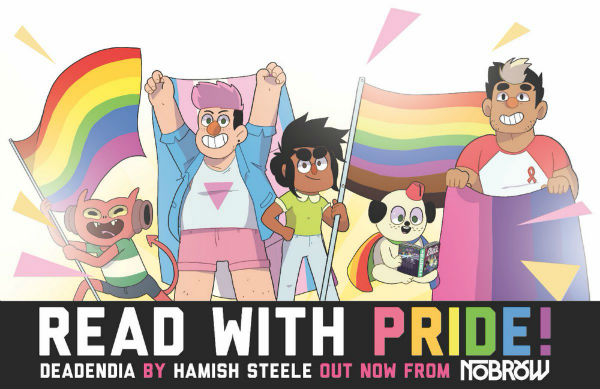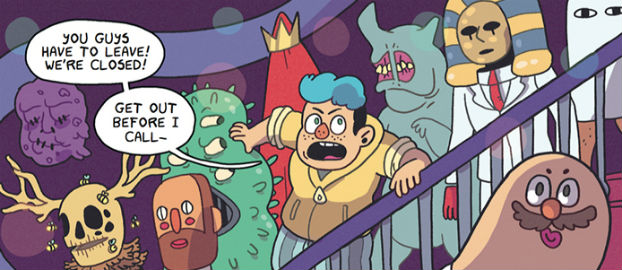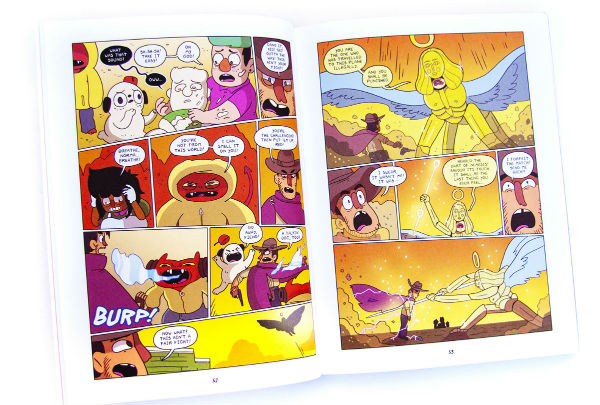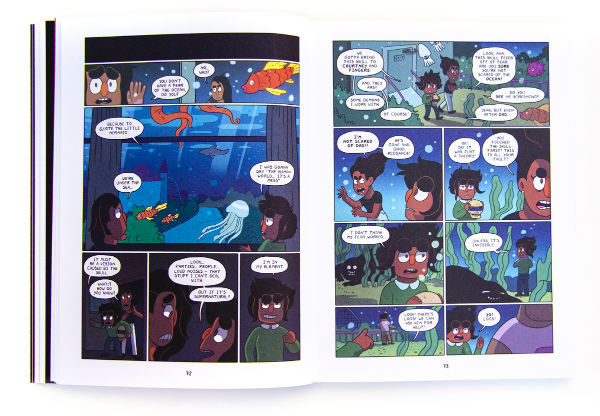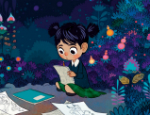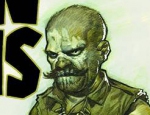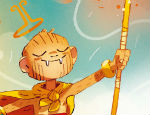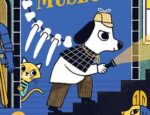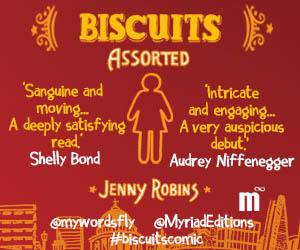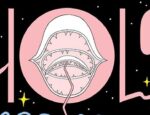Pantheon by Hamish Steele is one of my all-time favourite graphic novels, so I was really excited to read his new one DeadEndia. It’s pitched for a slightly younger audience so has less truly weird sex and death stuff, but makes up for that with more truly weird human relationship stuff. You know, like in real life. Norma and Barney work at Dead End, a haunted house attraction at the heart of the Pollywood theme park that also happens to be a portal to the many planes of heaven and hell, but mostly the hell ones.
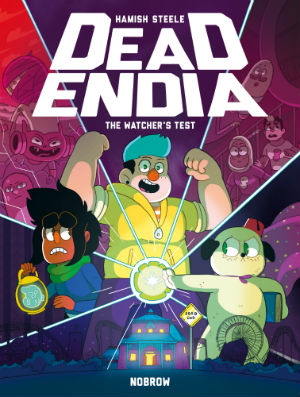 With his trademark straightforward absurdist approach to storytelling and loose-jointed, expressive cartoon style, Hamish Steele’s second graphic novel from Nobrow delivers a relatable rollercoaster of character-driven comedy. Other characters include an endlessly inventively drawn cast of demons and, more terrifyingly, Norma and Barney’s human theme park co-workers. One of my favourite parts early in the story shows Norma pointing these out to Barney and describing them only by their jobs: “there’s Deathslide. She runs the guillotine attraction… she once invited me to a party and I didn’t go. Obviously I can never speak to her again.” Spoilers guys: she does have to speak to her again.
With his trademark straightforward absurdist approach to storytelling and loose-jointed, expressive cartoon style, Hamish Steele’s second graphic novel from Nobrow delivers a relatable rollercoaster of character-driven comedy. Other characters include an endlessly inventively drawn cast of demons and, more terrifyingly, Norma and Barney’s human theme park co-workers. One of my favourite parts early in the story shows Norma pointing these out to Barney and describing them only by their jobs: “there’s Deathslide. She runs the guillotine attraction… she once invited me to a party and I didn’t go. Obviously I can never speak to her again.” Spoilers guys: she does have to speak to her again.
DeadEndia has garnered acclaim and enthusiasm this year due to its cute, contemporary take on a few well-loved genres. Part coming-of-age friendship soap drama, part monster-of-the-week action horror romp, there’s also elements of workplace comedy, time-travel apocalypse and downright farce. The subtexts of the story offer the reader many layers of meta-irony, but ever so lightly so that it never feels overstated or clunky. The haunted house setting is many things at once, a critique of commercial celebrity culture through the film star theme-park setting; an exploration of morality and theology with the comparison of ambiguous angels and demons… I’m probably over-analysing at this point. There are also a lot of bum jokes.
The comic wears its diversity credentials on its sleeve, but lightly too, always secondary to the story. In many ways this is the content we have been crying out for: stories about characters of a range of backgrounds, sexual/gender identities and neuro-profiles who do have meaningful personal journeys within those scopes, but BECAUSE of and DURING the challenges they are facing due to more pedestrian concerns. Concerns such as summoning the courage to talk to someone you like, and battling a demon king who has possessed the body of your dog. After Pugsley’s demon possession in the first story arc he remembers the ability to speak and becomes the third central character. Hijinks ensue.
Steele has artfully mashed up a lot of disparate elements while keeping a clear, consistent narrative voice throughout. Where Pantheon, took a fresh, contemporary approach to classical content, DeadEndia brings together a number of mythologies and perspectives. Both books have healthy helpings of quirky cartoon fun, but in some ways they are opposites. Pantheon’s cast of gods mostly did whatever they wanted with total deadpan selfishness, inflicting their whims on the human world. In DeadEndia the human characters have the whims of demons thrust upon them, but are also constricted by the social expectations of their lives. The episodic nature of the story structure here also feels much more televisual. This is not particularly surprising since the world originated in a cartoon short, and was then serialised as a webcomic.
Back when we were lovely cave people telling our comics with lovely paintings of buffalo on the wall, I’ll bet there were some naturally occurring stylistic differences between the stories we told round the campfire to just our mates on a regular day and the stories we told to the whole village on a festival day when we wore our fancy masks and had to make sure those visiting elders didn’t get confused about what the animal spirits represented. Plus they probably wouldn’t get our in-joke about how the hurricane god sounds just like the old herb woman.
What the Dickens am I talking about? Oh yeah, short-form long-form transition. It’s a tricky business. Narrative webcomics, when done well, are stories within stories within stories. Picking the moment to click next is perhaps even more crucial than the page turn is in printed format. It is a testament to Hamish Steele’s wit and skill that DeadEndia has transitioned so beautifully into graphic novel form, although the episodic format still dominates. Because this is a webcomic, which started as an animated short, evolved, became a serial printed comic, which then became a book, the story and characters have had lots of chances to develop and grow in depth and creativity. Barney, Norma and Pugsley are instantly engaging characters, perhaps because they have lived inside Steele’s head and in his various incarnations of the project for so long.
I always like thinking about how human creativity is shaped by experience and circumstance. Dead End started as three friends renting a haunted house in the desert and thus being mildly distracted from their internet addiction (you can see the original cartoon above). In some other universes the short successfully became a full-fledged adult cartoon series. I don’t know if we need more of those to be honest. I’m glad in this universe it became the more family-friendly incarnation; 12-year-olds and above need to be exposed to this kind of genre-mashing absurdity too, and adult readers don’t need all of their content to be super cynical. Pick up DeadEndia for a heart-warming dose of smart supernatural silliness.
Hamish Steele (W/A) • Nobrow Press, £12.99
Review by Jenny Robins





